The Zanclean Deluge - How the Mediterranean Sea was created 5.33 million years ago
By Nick Nutter | Updated 19 Mar 2022 | Andalucia | History |
Login to add to YOUR Favourites or Read Later
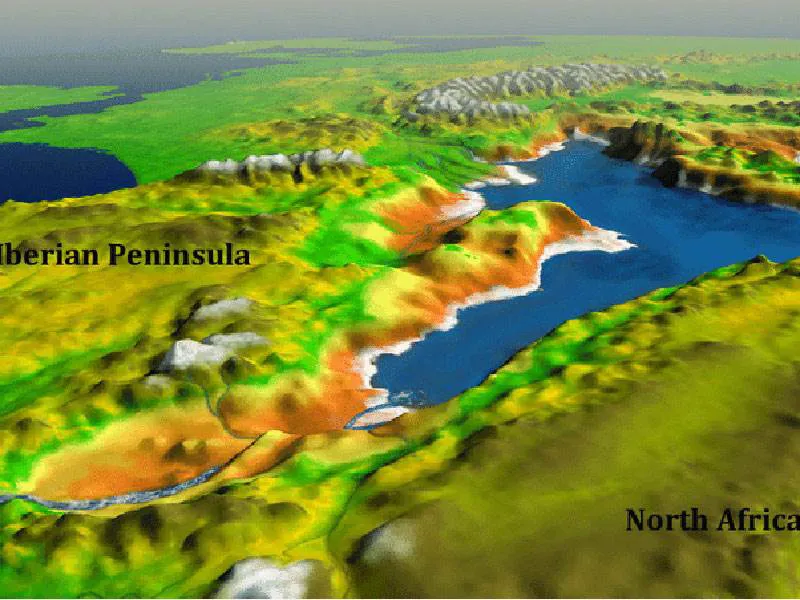
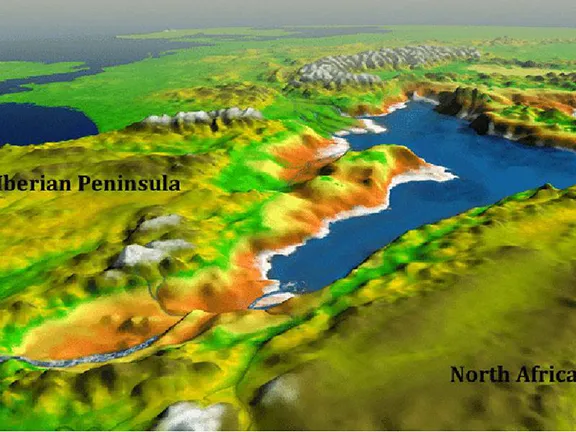
Zanclean Deluge
Our story starts, appropriately, at a point considered by classical Greeks and Romans as the end of the world, the Pillars of Hercules, or as they are called today, the Rock of Gibraltar and Jebel Musa. Over 5 million years ago, the Rock was on the edge of a gorge through which a torrent of water flowed that filled the Mediterranean Sea Basin in just 37 years.
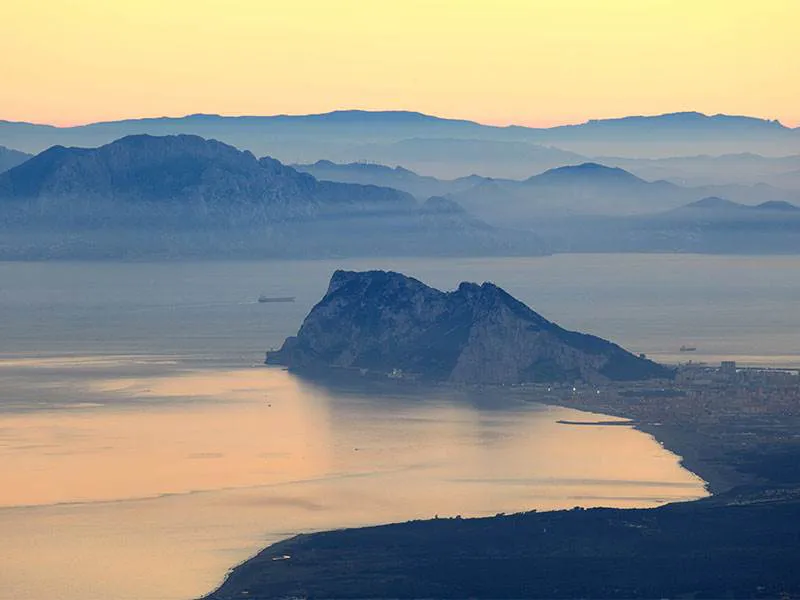
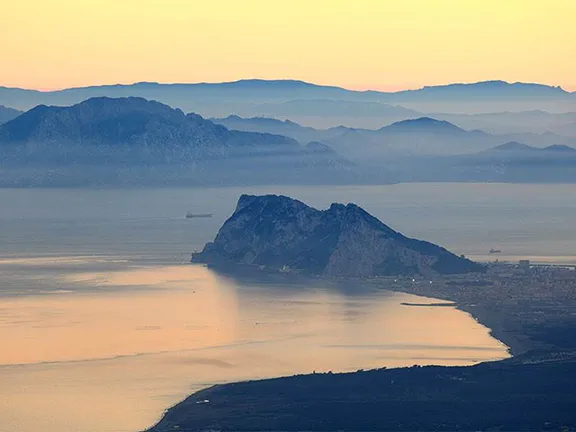
Pillars of Hercules - the Gibraltar Strait
The pillars first appear in Greek mythology associated with Heracles (Hercules) and mark the westernmost point of his travels during his twelve quests. The Greek myths were later adopted by the Romans and they modified the Greek so that Hercules, whilst making his way to the garden of the Hesperides on the island of Erytheia, rather than climb over a mountain called Atlas that lay in his path, used his superhuman strength to stamp on the mountain and thus open up the Strait that allowed water to flow into the Mediterranean from the Atlantic Ocean. Words recorded in mythology that are, coincidentally and purely by accident, very close to the geological truth.
Standing at Jews Gate on Gibraltar, beneath the concrete monument representing the northern pillar you can look south and see the southern pillar, Jebel Musa. Between is the Gibraltar Strait, the stretch of sea that separates the Atlantic Ocean, to your right or west, and the Mediterranean Sea to your left or east. At this point, the Strait is about 20 kilometres wide but at its narrowest, a few miles west, it is only 14 kilometres from one side to the other.
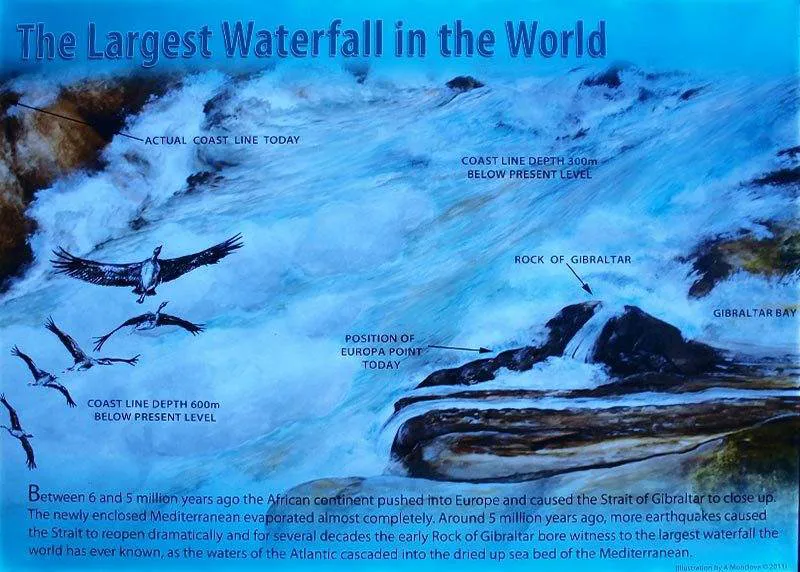
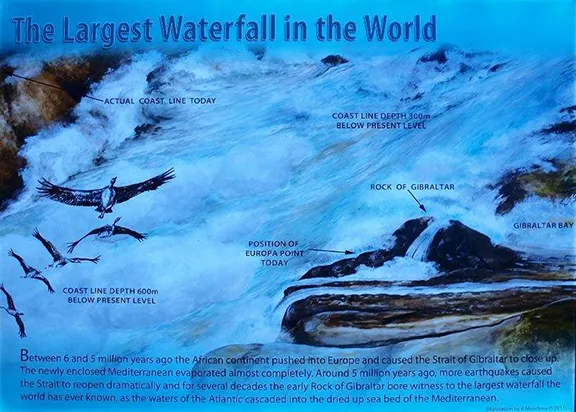
Artists Impression
Our story starts not just at this point but also at a particular time – 5.33 mya (million years ago) when the view would have been very different. For this part, you must use your imagination although every element is real. Between you and Jebel Musa, there is an 800 metres deep canyon with two large buttes. To your right, the west, the floor of the canyon rises steeply until about 40 kilometres west a saddleback ridge connects the Iberian Atlantic seaboard coastal mountain chain to that in North Africa and beyond it but out of sight beneath the ridgeline are the glittering blue waters of the Atlantic Ocean. For 270,000 years the ridge had acted as a bridge between Africa and Europe over which vegetation and animals had crossed.
Bisecting the ridge and cascading down the canyon is a river. Its origins are far to the northeast from where it flows west and then south, it is the early Rio Guadalquivir. Looking to the east the floor of the canyon descends steeply to 1500 metres into a barren, hot, dry abyss that opens out into a wide valley bounded to the north by the now coastal mountains of Iberia and to the south by the African landmass. You may notice, on the floor of this vast depression, star-like reflections of light. These are from the thick covering of salt crystals that poison the land and prevent the growth of any plants. A few lakes of deep cerulean blue reflect the blue of the tropical sky. These brine lakes are the only remnants of the sea that once filled this depression. If you were able to see that far you would notice the depression extends to another high ridge, this one between modern-day Sardinia and Tunisia and beyond that another deep depression that extends as far as the east coast of the modern Mediterranean. In the centre of this eastern depression, there is a body of water, named by geologists, Lake Cyrenaica.
At Jews Gate the day is hot and humid. To the west, a violent thunderstorm hurls water from black cumuli nimbus clouds onto the west coast of this supercontinent. Breakers crash into the western side of the ridge, just as they do today at Tarifa a few kilometres down the coast. Across the lightly wooded ridge, in Africa, the land is covered in a savannah-like vegetation, lush grasses and stands of trees. What is now the Sahara desert is crisscrossed by rivers and streams whose waters collect in four large lakes, the largest of which is Lake Chad, many times the size it is today. The vegetation changes across Africa.
Over the dry Mediterranean depression low pressure areas started developing about 5.8 mya bringing in moist air from the Atlantic and from the Indian Ocean. On the northeast coast of Africa an annual south-easterly monsoon allowed the growth of canopied rain forest. The further north and west you travel from the northeast coast the sparser the vegetation until at the north and west coasts there is a savannah type of environment. The area surrounding Lake Chad in central Africa was a happy mix of savannah and forest. Water from the lakes across this part of the continent made their way east to join the river Nile, then a much mightier river than it is today. Its waters cascaded down into the eastern depression keeping Lake Cyrenaica in a delicate balance.
Water evaporated faster from the lake than it was replenished, just as water today from the Mediterranean evaporates faster than it can be replenished from the rivers that now flow into it. Today there is a constant flow of water from the Atlantic into the Mediterranean to make up the shortfall. 5.33 mya Lake Cyrenaica was at its lowest level ever.
5.33 mya, beneath the trees on the ridge a momentous event was occurring. The waters from the western hills collected in streams that flowed into the Guadalquivir flowing down the east side of the ridge. For hundreds of thousands of years, these have been eating at the ridge, cutting themselves back towards the west. A particularly violent wave crashed ashore and the highest part managed to reach the very tip of one of those streams. Its back wash cut a small channel towards the tide. A breach had been made in the ridge.
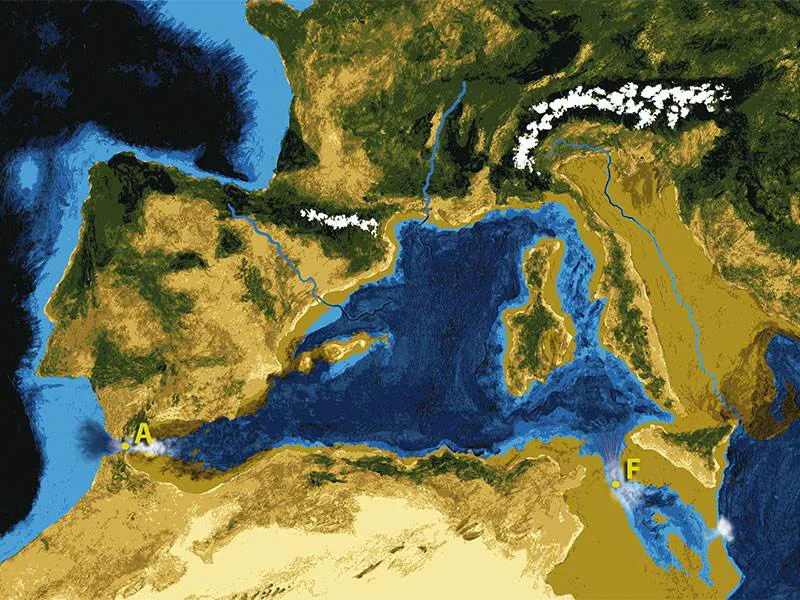
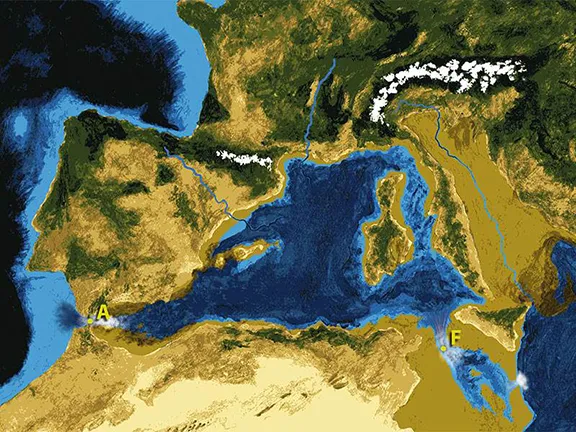
A marks the spot
For 26 years the Atlantic trickled into the head of the river, each year the breach became wider and deeper and the flow increased. Then, one day, there was another violent storm and the entire centre section of the ridge collapsed, perhaps helped by an earthquake, just as if Hercules had stamped his foot on it. The debris was hurled forward on a torrent. The Atlantic poured into the western basin at a rate of up to 100 million cubic metres per second, 1000 times the rate of the present-day Amazon river. Water cascaded over Europa point and battered into the western face of The Rock. What is now Gibraltar Bay was a maelstrom of foaming water as the Atlantic surged over what is now the isthmus. It took just 10 years to fill to the height of the ridge between Sardinia and Tunisia. It took a further one year to fill the eastern depression. The Mediterranean was reborn in just 37 years. This event became known as the Zanclean Deluge.
Given the length of time since the Zanclean Deluge, it is extraordinary that the event can be described in such exact detail, isolating an event that happened over a period of just a few years some 5.33 million years ago. The evidence comes from deep-sea drilling. The seafloor captures the sediment laid down over the millennia and these layers contain pollen from the plants that grew in the surrounding areas that drained into the sea. Like tree rings, the annual layers can be counted with surprising accuracy and the size and shape of the granules that make up the sand, mud, clay and rock also tell their story of where they came from and the climatic conditions appertaining at the time. Fossils of sea creatures and plants captured in the sediment embellish the tale. Reading and interpreting a core is a fascinating and hugely complex undertaking but it does provide invaluable information from which to determine the climate and vegetation in an area thousands and millions of years ago.
The recreation of the Mediterranean, combined with two other events effectively changed the climate in this part of the world. The world itself would never be the same again.
The second event that would eventually alter the world’s climate started about 8 million years ago. The African, European, Arabian, Asian and Indian continental plates were involved in a complicated fandango. In the preceding 500 thousand years, The Arabian plate had slid between the Indian and European to block off an eastern arm of the ancient Tethys Sea, thus creating the first, short-lived, Mediterranean Sea. About 5.6 mya the African plate had pushed north into the European plate, cutting off the western end of the new Mediterranean and the Indian plate was pushing north into the Asian plate. Over the following 270,000 years, the now entrapped Mediterranean all but evaporated.
This last movement raised the Tibetan Plateaux over the following 3 million years or so until it was of sufficient height to kick start the south-west monsoon that now takes water from the Indian Ocean and deposits it on the slopes of the Himalayas from where it descends to join the mighty rivers of India, the Ganges that flows into the Bay of Bengal and the Indus that flows into the Arabian Sea.
The climate of Europe and northern Africa thus lost the benefit of its monsoon. The canopied forests retreated to be replaced by open forest which was in turn replaced by savannah and in places, arid grasslands gave way to semi-arid regions and desert much as it is today.
Whilst the first two events were unique and will never happen again, the third event actually recurs every 19 to 23 thousand years. The Earth wobbles on its axis as it proceeds in its orbit and as it does so the area on the Earth’s surface that receives the maximum amount of sunshine over the year moves around. 5.8 mya this area was over north Africa helping create the low pressure and consequentially the south-east monsoon. Today it is over the Indian Ocean helping the creation of the south-west monsoon. This effect is known as insolation and the cycles associated with it are called Milankovitch cycles.
Returning to 5.33 mya. No human witnessed the Zanclean deluge. At that time there were a number of primates, chimpanzee sized apes that could walk upright, living in Africa at sites like Lake Chad. Species such as Ardipithecus kadabba represented a new evolutionary path that had split from that of the apes between 8 and 6 million years ago and were on their way to being fully human. Vegetation at the time ranged from canopy forest to savannah and this habitat was shared with giant hyenas, sabre-toothed cats, giraffes, antelopes, horses, monkeys, pigs and hippopotami. The reptiles were represented by pythons and lizards, tortoise and turtles. The lakes were filled with freshwater fish. Ardipithecus kadabba ate roots, fruit and berries and may have broadened their diet with shellfish scavenged from the lakeshore but it would be many years before they start to scavenge for meat.
The Zanclean deluge had one more lasting effect on the human species. It effectively cut off any communication between Africa and Europe. The Middle East was an arid zone in which few plants, no herbivores and therefore no predators could exist. Any primates stranded in Asia or Europe continued to evolve but did not follow the path that led to Homo sapien. The human evolutionary line continued to evolve in Africa but, apart from a few periods of time when the weather patterns changed such that northeastern Africa and the Middle East became verdant allowing grasses and herbs to grow, they were stranded in Africa.
Not until about 2 million years ago did a species manage to leave Africa to follow the herbivores and predators into Europe and Asia and that was more a very gradual dispersal over thousands of years rather than a migration. That story can be taken up at a site in Granada province, a small town called Orce where, it is claimed, the remains of the oldest Europeans have been found dating back some 1.4 million years.
Clive Finlayson – ‘The Humans Who Went Extinct’ (30-31, 34) (2009)
Victoria Gill Science reporter, BBC News – ‘Ancient Mediterranean flood mystery solved’ (2009)
D. Garcia-Castellanos & A. Villaseñor ‘Messinian salinity crisis regulated by competing tectonics and erosion at the Gibraltar arc’ (Nature Magazine December 2011)
Jew’s Gate Gibraltar - The Pillars of Hercules
Gibraltar Museum
Harding Battery -Europa Point, Gibraltar